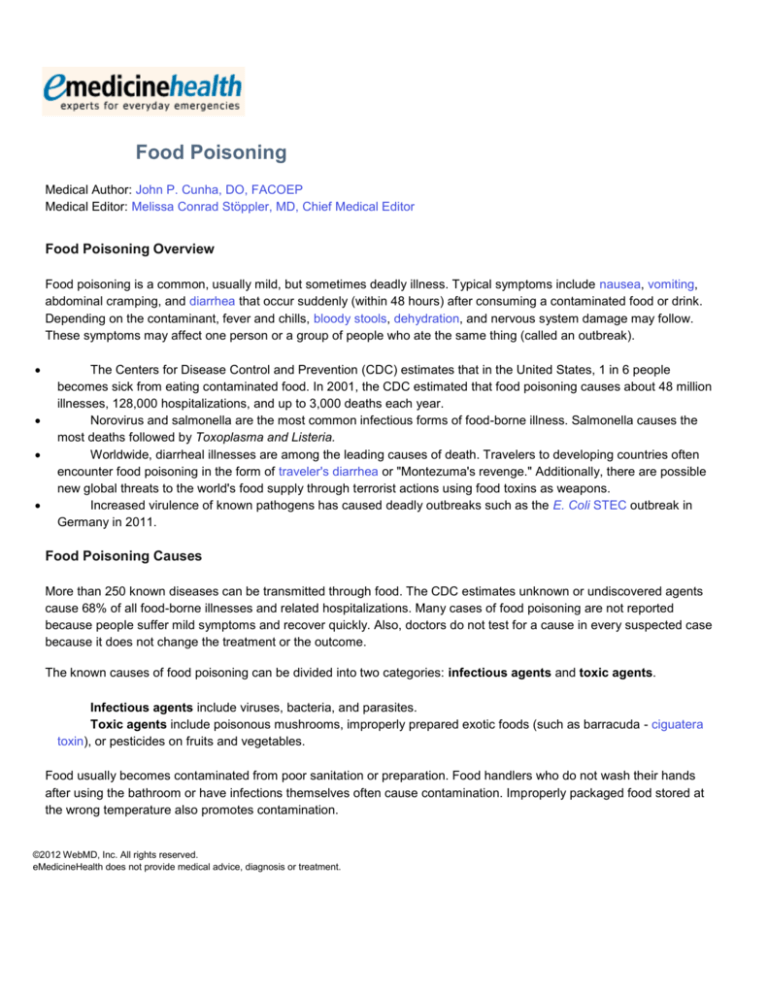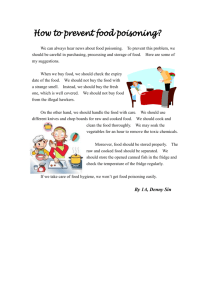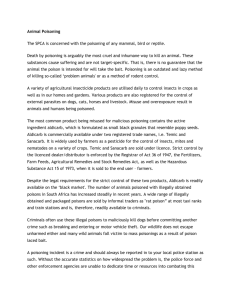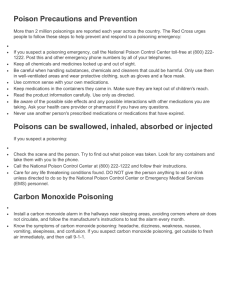
Food Poisoning
Medical Author: John P. Cunha, DO, FACOEP
Medical Editor: Melissa Conrad Stöppler, MD, Chief Medical Editor
Food Poisoning Overview
Food poisoning is a common, usually mild, but sometimes deadly illness. Typical symptoms include nausea, vomiting,
abdominal cramping, and diarrhea that occur suddenly (within 48 hours) after consuming a contaminated food or drink.
Depending on the contaminant, fever and chills, bloody stools, dehydration, and nervous system damage may follow.
These symptoms may affect one person or a group of people who ate the same thing (called an outbreak).
The Centers for Disease Control and Prevention (CDC) estimates that in the United States, 1 in 6 people
becomes sick from eating contaminated food. In 2001, the CDC estimated that food poisoning causes about 48 million
illnesses, 128,000 hospitalizations, and up to 3,000 deaths each year.
Norovirus and salmonella are the most common infectious forms of food-borne illness. Salmonella causes the
most deaths followed by Toxoplasma and Listeria.
Worldwide, diarrheal illnesses are among the leading causes of death. Travelers to developing countries often
encounter food poisoning in the form of traveler's diarrhea or "Montezuma's revenge." Additionally, there are possible
new global threats to the world's food supply through terrorist actions using food toxins as weapons.
Increased virulence of known pathogens has caused deadly outbreaks such as the E. Coli STEC outbreak in
Germany in 2011.
Food Poisoning Causes
More than 250 known diseases can be transmitted through food. The CDC estimates unknown or undiscovered agents
cause 68% of all food-borne illnesses and related hospitalizations. Many cases of food poisoning are not reported
because people suffer mild symptoms and recover quickly. Also, doctors do not test for a cause in every suspected case
because it does not change the treatment or the outcome.
The known causes of food poisoning can be divided into two categories: infectious agents and toxic agents.
Infectious agents include viruses, bacteria, and parasites.
Toxic agents include poisonous mushrooms, improperly prepared exotic foods (such as barracuda - ciguatera
toxin), or pesticides on fruits and vegetables.
Food usually becomes contaminated from poor sanitation or preparation. Food handlers who do not wash their hands
after using the bathroom or have infections themselves often cause contamination. Improperly packaged food stored at
the wrong temperature also promotes contamination.
©2012 WebMD, Inc. All rights reserved.
eMedicineHealth does not provide medical advice, diagnosis or treatment.
Poisoning
Medical Author: John P. Cunha, DO, FACOEP
Medical Editor: Melissa Conrad Stöppler, MD, Chief Medical Editor
Poisoning Overview
Topic Overview
A poison is a substance that has toxic effects and may injure you or make you sick if you are exposed to it. Poisons can
be found everywhere, from simple household cleaners to cosmetics to houseplants to industrial chemicals. Even
medicines that are taken in the wrong dose, at the wrong time, or by the wrong person can cause a toxic effect.
Poisonous substances can hurt you if they are swallowed, inhaled, spilled on your skin, or splashed in your eyes. In most
cases, any product that gives off fumes or is an aerosol that can be inhaled should be considered a possible poison. More
than 90% of poisonings occur in the home.
Poisoning Overview
Poison is anything that kills or injures through its chemical actions. Most poisons are swallowed (ingested). The word
poison comes from the Latin word - potare - meaning to drink. But poisons can also enter the body in other ways: By
breathing, through the skin, by IV injection, from exposure to radiation, or venom from a snake bite
Symptoms of poisonings
The symptoms of a suspected poisoning may vary depending on the person's age, the type of poisonous substance, the
amount of poison involved, and how much time has passed since the poisoning occurred. Some common symptoms that
might point to a poisoning include:
Nausea and vomiting.
Cramps.
Throat pain.
Drooling.
Sudden sleepiness, confusion, or decreased alertness.
Anxiousness, nervousness, irritability, or tremors.
Seizures.
Substance residue or burn around the mouth, teeth, eyes, or on the skin.
Trouble breathing.
Headache.
©2012 WebMD, Inc. All rights reserved.
eMedicineHealth does not provide medical advice, diagnosis or treatment.








